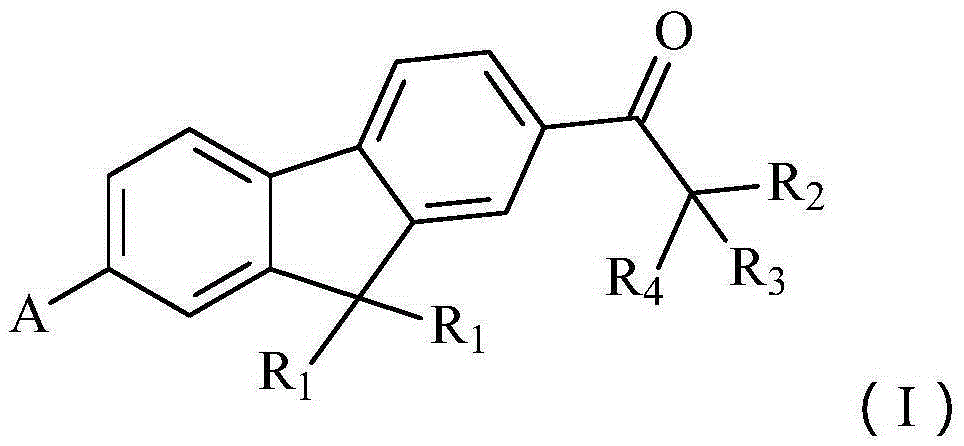Fluorene polyfunctionality photoinitiator and preparation and applications thereof
A multifunctional, photoinitiator technology, which is applied in the preparation of carbon-based compounds, the preparation of organic compounds, and the preparation of carbonyl compounds by condensation. Excellent initiating activity, low migration, and excellent film-forming properties
- Summary
- Abstract
- Description
- Claims
- Application Information
AI Technical Summary
Problems solved by technology
Method used
Image
Examples
Embodiment 1
[0038]
[0039] Step (1): Preparation of intermediate 1a
[0040]Add 97g of raw material 1a, 67g of aluminum trichloride, and 100mL of dichloromethane into a 500mL four-necked flask, drop the mixed solution of 54g of raw material 1b, that is, isobutyryl chloride and 50mL of dichloromethane in an ice-water bath, and control the temperature Below 10°C, drop it for about 2 hours, continue to stir for 2 hours after the drop, follow the liquid phase until the reaction is complete, then slowly pour the material into dilute hydrochloric acid made of 800g ice water and 100mL concentrated hydrochloric acid (37%), and add While stirring, pour it into a separatory funnel, separate the lower dichloromethane layer, and continue to wash the water layer with 50mL of dichloromethane, combine the dichloromethane layers, and wash the mixture with 5% aqueous sodium bicarbonate (300mL each time, 3 times) ) to clean the dichloromethane layer, then wash the dichloromethane layer with water until...
Embodiment 2
[0055]
[0056] Step (1): Preparation of Intermediate 2a
[0057] Add 106g of raw material 2a, 67g of aluminum trichloride, and 100mL of dichloromethane into a 500mL four-neck flask, drop the mixed solution of 54g of isobutyryl chloride and 50mL of dichloromethane in an ice-water bath, and control the temperature below 10°C After about 2 hours of dropwise addition, continue to stir for 2 hours after the dropwise addition, follow the liquid phase until the reaction is complete, then slowly pour the material into the dilute hydrochloric acid made of 800g of ice water and 100mL of concentrated hydrochloric acid, stir while adding, and then pour into the In the liquid funnel, separate the lower dichloromethane layer, and continue to wash the water layer with 50mL of dichloromethane, combine the dichloromethane layer, wash the dichloromethane layer with 5% aqueous sodium bicarbonate solution (300mL each time, 3 times), Then the dichloromethane layer was washed with water until t...
Embodiment 3
[0072]
[0073] Step (1): Preparation of Intermediate 3a
[0074] Add 111g of raw material 3a, 134g of aluminum trichloride, and 200mL of dichloromethane into a 1000mL four-neck flask, drop the mixed solution of 107g of isobutyryl chloride and 100mL of dichloromethane in an ice-water bath, and control the temperature below 10°C After about 2 hours of dropwise addition, continue to stir for 2 hours after the dropwise addition, and follow the liquid phase to complete the reaction, then slowly pour the material into the dilute hydrochloric acid made of 800g of ice water and 150mL of concentrated hydrochloric acid, stir while adding, and then pour into the divided In the funnel, separate the lower dichloromethane layer, and continue to wash the water layer with 100mL dichloromethane, combine the dichloromethane layers, and wash the dichloromethane layer with 5% aqueous sodium bicarbonate solution (300mL each time, 3 times). Then the dichloromethane layer was washed with water u...
PUM
 Login to View More
Login to View More Abstract
Description
Claims
Application Information
 Login to View More
Login to View More - R&D
- Intellectual Property
- Life Sciences
- Materials
- Tech Scout
- Unparalleled Data Quality
- Higher Quality Content
- 60% Fewer Hallucinations
Browse by: Latest US Patents, China's latest patents, Technical Efficacy Thesaurus, Application Domain, Technology Topic, Popular Technical Reports.
© 2025 PatSnap. All rights reserved.Legal|Privacy policy|Modern Slavery Act Transparency Statement|Sitemap|About US| Contact US: help@patsnap.com



